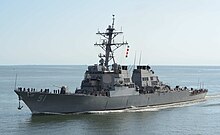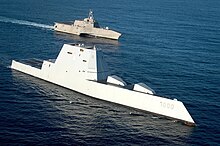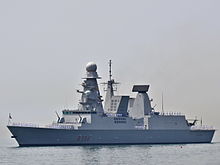
Back Torpedojaer Afrikaans مدمرة Arabic Esmines Azerbaijani Эскадраны мінаносец Byelorussian Разрушител Bulgarian ডেস্ট্রয়ার Bengali/Bangla Lestr-distruj Breton Razarač BS Destructor Catalan Torpédoborec Czech



In naval terminology, a destroyer is a fast, maneuverable, long-endurance warship intended to escort larger vessels in a fleet, convoy, or carrier battle group and defend them against a wide range of general threats. They were originally conceived in 1885 by Fernando Villaamil for the Spanish Navy[1][2] as a defense against torpedo boats, and by the time of the Russo-Japanese War in 1904, these "torpedo boat destroyers" (TBDs) were "large, swift, and powerfully armed torpedo boats designed to destroy other torpedo boats".[3] Although the term "destroyer" had been used interchangeably with "TBD" and "torpedo boat destroyer" by navies since 1892, the term "torpedo boat destroyer" had been generally shortened to simply "destroyer" by nearly all navies by the First World War.[4]
Before World War II, destroyers were light vessels with little endurance for unattended ocean operations;[citation needed] typically, a number of destroyers and a single destroyer tender operated together.[citation needed] After the war, destroyers grew in size. The American Allen M. Sumner-class destroyers had a displacement of 2,200 tons, while the Arleigh Burke class has a displacement of up to 9,600 tons, a difference of nearly 340%. Moreover, the advent of guided missiles allowed destroyers to take on the surface-combatant roles previously filled by battleships and cruisers. This resulted in larger and more powerful guided missile destroyers more capable of independent operation.
At the start of the 21st century, destroyers are the global standard for surface-combatant ships, with only two nations (the United States and Russia) officially operating the heavier cruisers, with no battleships or true battlecruisers remaining.[note 1] Modern guided-missile destroyers are equivalent in tonnage but vastly superior in firepower to cruisers of the World War II era, and are capable of carrying nuclear-tipped cruise missiles. At 510 feet (160 m) long, a displacement of 9,200 tons, and with an armament of more than 90 missiles,[5] guided-missile destroyers such as the Arleigh Burke class are actually larger and more heavily armed than most previous ships classified as guided-missile cruisers. The Chinese Type 055 destroyer has been described as a cruiser in some US Navy reports due to its size and armament.[6]
Many NATO navies, such as the French, Spanish, Dutch, Danish, and German, use the term "frigate" for their destroyers, which leads to some confusion.[citation needed]
- ^ Cite error: The named reference
Bernie2was invoked but never defined (see the help page). - ^ Smith, Charles Edgar: A short history of naval and marine engineering. Babcock & Wilcox, ltd. at the University Press, 1937, page 263
- ^ Gove p. 2412
- ^ Lyon pp. 8, 9
- ^ Northrop Grumman christened its 28th Aegis guided missile destroyer, William P. Lawrence (DDG 110) April 19, 2010. Retrieved August 29, 2014.
- ^ "Annual Report to Congress: Military and Security Developments Involving the People's Republic of China 2017" (PDF). Office of the Secretary of Defense. Archived (PDF) from the original on 2017-08-28. Retrieved 1 July 2021.
Cite error: There are <ref group=note> tags on this page, but the references will not show without a {{reflist|group=note}} template (see the help page).